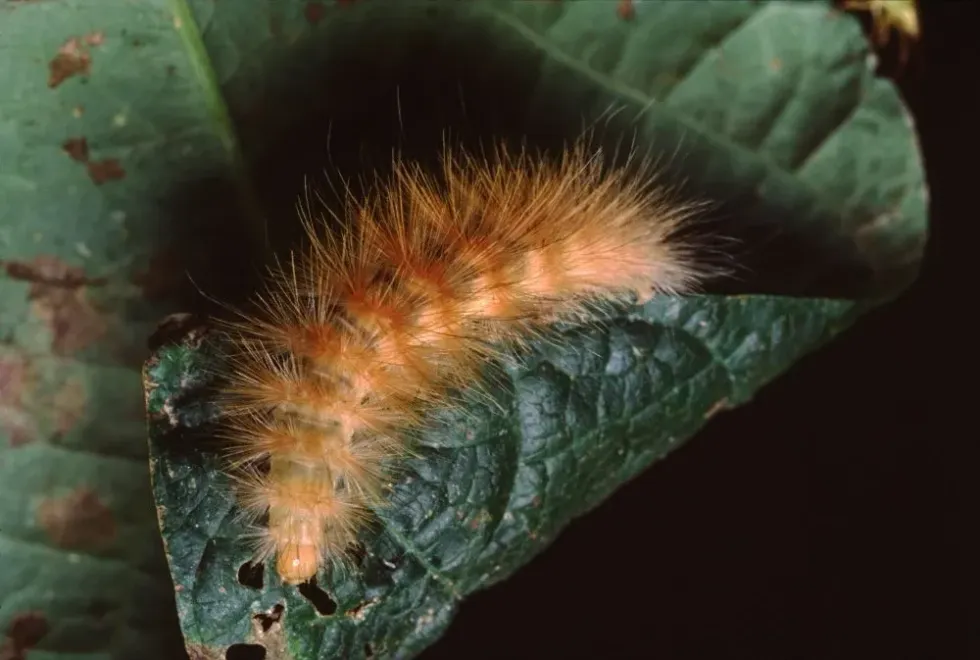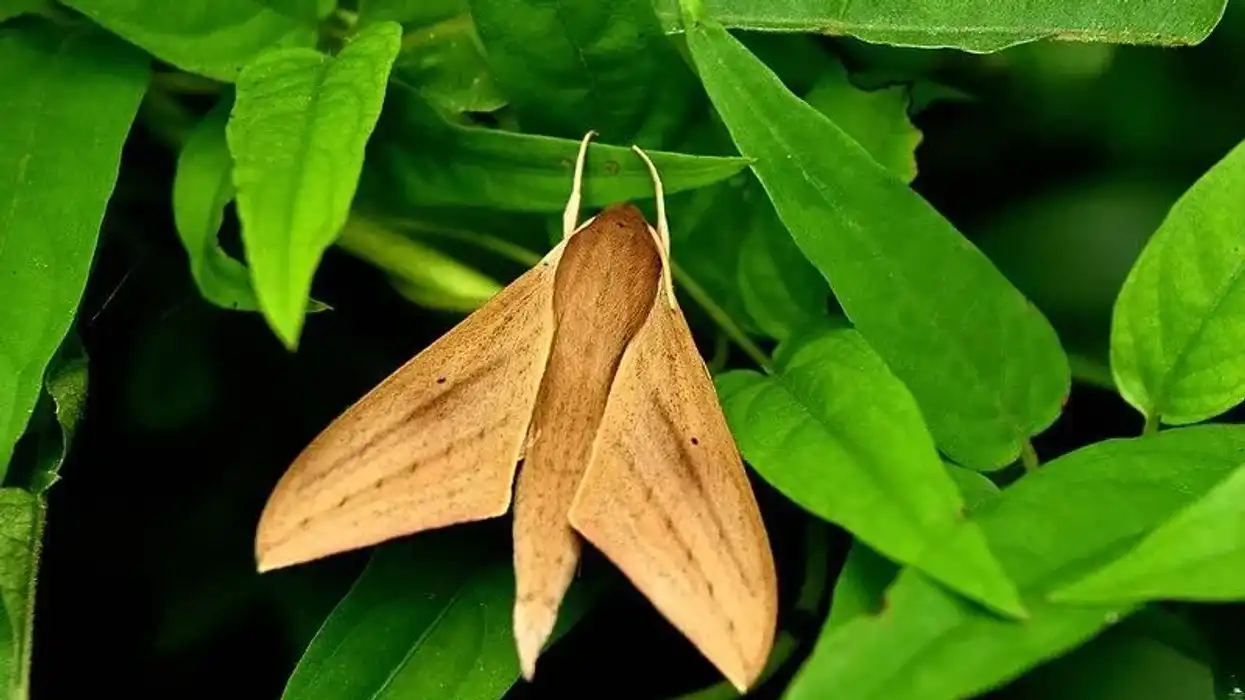The Virginian tiger moth (Spilosoma virginica) is known by many names like the yellow woolly bear or yellow bear caterpillar, when in the caterpillar stage. The moth stage of this species is also known by the name of Virginia tiger moth.
These tiger moths are a species of moths found in most states in the US. The insects called the Virginia tiger moth caterpillars becomes the Virginia tiger moth at a later stage.
The caterpillars have bristles (hairs) on their body which are not poisonous.
The hairs also do not cover the body of the Virginia tiger moth caterpillars fully like in other caterpillars. Although the caterpillar is named wooly bear caterpillar, this insect does not possess the consistency of wool in the hair of the body.
A member of the order Lepidoptera in the subfamily of Arctiinae and with the scientific name Spilosoma virginica, Virginian tiger moth, or the yellow bear caterpillar are known to shed their hairs and use them as part of the cocoon. The Virginia tiger moths are found in Michigan and Wisconsin in the US and Canada, Mexico elsewhere.
Learn more about some other species of the moths like Io moth facts and regal moth facts for more about the animal kingdom.
Virginian Tiger Moth Interesting Facts
What type of animal is a Virginian tiger moth?
Virginian tiger moth is a species of moth found mostly in the US.
What class of animal does a Virginian tiger moth belong to?
The Virginian tiger moth (Spilosoma virginica) falls under the class of Insecta in the Kingdom of Animalia. They are a member of the order Lepidoptera of the family Erebidae and subfamily of Arctiinae.
How many Virginian tiger moth are there in the world?
The population of the Virginian tiger moth is not known. Also, the low lifespan of the insects makes it difficult to keep count.
Where does a Virginian tiger moth live?
The Virginian tiger moth is found in local wetlands, grasslands, and woodlands. They are also found in many different species of plants in yards, gardens, and forests.
What is a Virginian tiger moth‘s habitat?
This species is found almost in all the lower 48 states of the United States and southern Canada going south into Central America. The name Virginia for the caterpillars comes from their origins in the state of Virginia.
Virginia tiger moths are found mostly in North America and commonly found in the east of the US.
They are also seen in Mexico sometimes.
The range of territorial areas of this species includes Alabama, Arkansas, Connecticut, Delaware, Florida, Georgia, Illinois, Indiana; Iowa, Kansas, Kentucky, Louisiana, Maine, Maryland, Massachusetts, Michigan, Minnesota, Mississippi, Missouri, Nebraska, New Hampshire, New Jersey, New York, North Carolina, North Dakota, Ohio, Oklahoma, Pennsylvania, Rhode Island, South Carolina, South Dakota, Tennessee, Texas, Vermont, Virginia, West Virginia, Wisconsin, British Columbia, New Brunswick, Newfoundland, and Labrador.
It also includes Nova Scotia, Ontario, Prince Edward Island, Quebec, and Mexico.
Who do Virginian tiger moth live with?
There is not much information about the company of these tiger moths. They are seen to feed alone most of the time.
How long does a Virginian tiger moth live?
The life of the Virginian tiger moth is short and all the five stages to an adult are completed in 2-3 weeks. The adult of the tiger moths does not eat as their body does not have that functionality. The life of these adults lasts for 5-10 days.
How do they reproduce?
The reproduction and life cycle of these species are divided into five stages until the caterpillar reaches the adult state. The first stage is the eggs, the second stage is the caterpillar, the third stage is the pupa, the fourth stage is the pupa in its cocoon, and the last stage is the adult stage of becoming a moth.
In the larva form, females are larger than males. Reproduction season begins as the adult females emit a pheromone and the males are able to smell by their large, feathered antennae. They fly in a zigzag pattern in search of the female and eventually home in. The males then leave to find other females.
The females lay 20-100 eggs on the underside of a leaf in host plants. The larvae are seen together. They become solitary with age.
They have 2-3 life cycles per year. One of these is seen hibernating in temperate climates in the winter.
What is their conservation status?
The IUCN has not listed this species. However, there is no threat to the life of the Virginian tiger moth currently and the reproduction of the insects is also seen being carried out in extensive numbers.
Virginian Tiger Moth Fun Facts
What do Virginian tiger moth look like?

Virginian tiger moths have many colorful species, but this insect has only black and white coloration. The caterpillars have variable colors of beige, yellow, dark red-brown, or black. Even the yellow has many different variations like pale/white, butter yellow to a rusty, and orange-yellow.
The young ones are colored yellow-green and have black hair. The black hairs become denser and bristle as the insects mature.
The black hairs also become turn uneven all throughout the body with uneven lengths. This makes the caterpillar look like a clump of black wool. The caterpillars shed the hairs and used them as part of the cocoon.
The adult moth is white colored with few black spots on the wings. The legs are furry and white with black spots. Males have antennae.
How cute are they?
The white body with black spots of the tiger moth can be considered pretty.
How do they communicate?
They probably communicate through pheromones during the reproduction period.
How big is a Virginian tiger moth ?
The length of the Virginian tiger moth is not available. They have a wingspan of 1.26-2.04 in (32-52 mm).
The ghost moth of the family Hepialidae, in comparison, has a wingspan of 1.8-2.75 in (4.6-7 cm).
How fast can a Virginian tiger moth run?
The speed of this moth is unknown.
How much does a Virginian tiger moth weigh?
The weight of this species has not been recorded.
What are the male and female names of the species?
Also known by the scientific name of Spilosoma virginica, Virginian tiger moth is the only name given to the species. The male and female are not given other names. It is also known by the name of yellow bear caterpillar when in the caterpillar stage.
What would you call a baby Virginian tiger moth?
Babies are called larvae or caterpillars.
What do they eat?
The Virginian tiger moth's diet includes cabbage and tobacco plants. Their food also includes tree leaves from birch, willow, maple, and walnut.
Commonly, moths have a lot of predators in the form of nocturnal insectivores and are food for birds like bats, owls, and some other species of birds. The tiger moths are also included in the diet of lizards, cats, and rodents. These animals feed on both the caterpillar form and the moth form.
Are they dangerous?
They are not dangerous to humans. The bristles present on the body of the caterpillar are also not poisonous. They however are capable of causing skin irritation to sensitive skin in humans. It may cause dermatitis in some people.
Would they make a good pet?
The insect called Virginian tiger moth is not considered a pet anywhere in the world.
Did you know...
They are not poisonous to anyone. The bristles can cause skin irritation in some.
They are found mostly in North America and can be considered endemic to the region.
Are Virginian tiger moth safe to touch?
The hair present in the body of this species of tiger moths can cause irritation in the skin.
How many eggs do Virginian tiger moth lay?
The females of Virginian tiger moths lay 20-100 eggs at a time in a season. The eggs are laid in a range of host plants.
Here at Kidadl, we have carefully created lots of interesting family-friendly animal facts for everyone to discover! For more relatable content, check out these leaf-footed bug facts or jewel beetle facts.
You can even occupy yourself at home by drawing one on our virginian tiger moth coloring pages.









